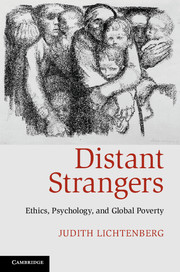Book contents
- Frontmatter
- Dedication
- Contents
- Preface
- Chapter 1 Introduction
- Chapter 2 Entanglements and the claims of mere humanity
- Chapter 3 Duties and rights, charity and justice
- Chapter 4 “Negative” and “positive” duties
- Chapter 5 Oughts and cans
- Chapter 6 Why people do what others do – and why that’s not so bad
- Chapter 7 Whose poor?/who’s poor?: deprivation within and across borders
- Chapter 8 Hopefully helping: the perils of giving
- Chapter 9 On motives and morality
- Chapter 10 Conclusion: morality for mere mortals
- Works cited
- Index
Chapter 1 - Introduction
Published online by Cambridge University Press: 05 June 2014
- Frontmatter
- Dedication
- Contents
- Preface
- Chapter 1 Introduction
- Chapter 2 Entanglements and the claims of mere humanity
- Chapter 3 Duties and rights, charity and justice
- Chapter 4 “Negative” and “positive” duties
- Chapter 5 Oughts and cans
- Chapter 6 Why people do what others do – and why that’s not so bad
- Chapter 7 Whose poor?/who’s poor?: deprivation within and across borders
- Chapter 8 Hopefully helping: the perils of giving
- Chapter 9 On motives and morality
- Chapter 10 Conclusion: morality for mere mortals
- Works cited
- Index
Summary
In 2008, 1.29 billion people – 22.4 percent of the world’s population – lived below the World Bank’s international poverty line of $1.25 a day. In sub-Saharan Africa, 47.5 percent of people live below the line. This absolute poverty line aims to denote the income “needed to purchase a very basic basket of food items, chosen to meet minimal nutritional requirements, and a similarly minimal set of essential nonfood items.” A “second tier” international poverty line of $2 a day puts 2.47 billion people in poverty. About one third of all deaths worldwide – 18 million a year – result from poverty-related causes; about 7 million children a year die of hunger and preventable diseases. The malnutrition rate for sub-Saharan Africa is 42 percent, for South Asia 47 percent. By contrast, about a billion people – including myself and just about anyone reading this book – live well by any reasonable standard. In North America the malnutrition rate is 4 percent.
This is a bad situation. It just doesn’t seem right. It shouldn’t be. What more can be said and what more should be said?
- Type
- Chapter
- Information
- Distant StrangersEthics, Psychology, and Global Poverty, pp. 1 - 18Publisher: Cambridge University PressPrint publication year: 2013



